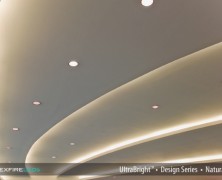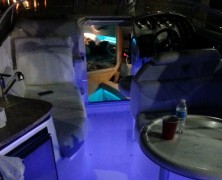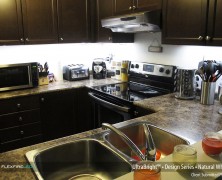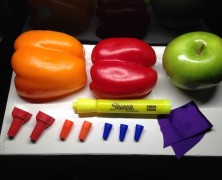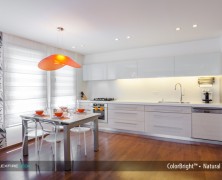Many people come to Flexfire LEDs with an interest in using LED strip lights for an indirect lighting project. Using indirect light is a vast aesthetic upgrade over cold, direct overhead light, and by using LEDs you will save on energy costs while living a more responsible and sustainable lifestyle. Here then are four indirect lighting ideas to add focus, texture and layering for your next home lighting redesign. Above and Under Cabinet LED Lighting Does your kitchen lack good lighting? With LED strip lights, also known as “tape lights,” adding beautiful, bright, indirect lighting to your kitchen is easier than ever. With our strong adhesive-backed strips, kitchen light remodeling is now a DIY project. Our experts can help walk you through the installation process, so you can easily attach lights where you want them, without any visible wires or components. Adding strips to a kitchen will add character, color and effective task lighting to the space you use to prepare and enjoy meals on a daily basis. For under and above cabinet lighting, we suggest our UltraBright™ Architectural series, which comes in three different color temperatures of white — warm, natural and bright. Under Counter LED Lighting Indirect, under counter LED lighting is a great way to add lighting appeal to commercial and residential spaces. Popular in bars and restaurants, the technique is also used at home to add flash, personality and warmth to home bars and kitchens. Adding RGB remote-controlled or single color strips is great for parties and giving the lighting setup a creative flare. Also, consider adding light strips under the counter kicker for floor lighting in kitchens and bathrooms. Flexfire LEDs’ UL listed UltraBright™ and ColorBright™ series LED strip lights come in a variety of colors and light temperatures to match...
Installing LED Strip Lights In Boats And Yachts...
posted by Flexfire LEDs
Looking to increase your boat lighting’s functionality and/or “bling” factor? If so, you’re not alone — we here at Flexfire LEDs get calls all the time with questions about installing LED strip lights in boats and yachts. So many in fact, that we’ve decided to share a few ideas and address some of the more common issues with this sort of installation. Whether you’re running a skipper or a barge, taking your boat out for pleasure or for fishing, LED strip lights are a great solution for low energy lighting that can be fully customized to meet the individual size and lighting demands of your boat. The first thing to consider when looking into LED strip lights for your boat is to determine whether the lights will be exposed to environmental elements such as water or sand. If you’re considering LED strips for your deck lighting, or perhaps outside of the hull, make sure the lights are rated for outdoor use and water protection. Each of our LED strip lights has an IP rating that specifies the amount and type of protection it receives from the elements. IP ratings consist of two numbers — the first number refers to the amount of protection against solid objects, and the second refers to liquid protection. The numbers for solid object protection run from 0 (no protection) through 6 (full protection), while the numbers for liquid protection run 0 through 8. A fully waterproof LED strip light would thus have a rating of IP68. For deck accent lighting, we suggest our colorful, customizable and versatile IP65 Outdoor ColorBright™ LED strip lights, which come in static red, green and blue, as well as remote-controlled color changing RGB. Many people call us looking to generate the attractive indirect glow they’ve seen on other boats. To achieve this...
How To Install Under Cabinet LED Strip Lighting...
posted by Flexfire LEDs
Under cabinet lighting is one of the most common applications of LED strip lights. This relatively easy installation is a fantastic addition to any kitchen, office, or work bench area that would benefit from high quality direct task lighting. To illustrate this installation, we’ve put together this step-by-step tutorial on how to install under cabinet LED strip lighting. For this tutorial, we reached out to a customer named Owen in Toronto, Canada. Owen was seeking bright, usable light in his kitchen that could be hard-wired to a standard wall dimmer, and told us he had been, “scouring the web off and on for three years” in search of the perfect solution. In the end, he chose Flexfire LEDs UltraBright LED strip lights in natural white after viewing some of our online installation videos and feeling comfortable with our product quality. It’s important to note that for this installation, Owen enlisted the help of a licensed professional electrician. This is something we recommend for all installations, as it ensures code compliance and avoids potential injuries due to improper handling. Here is a “before” photo of his kitchen, using only the existing overhead lighting. And now, onto the installation! In order to achieve proper brightness and even light distribution, he used our solderless connectors to run two parallel sections of LED strip lights under each of three cabinet sections. In the end, he felt that one single strip would have been more than enough, and this parallel run wasn’t actually necessary. Also, note that the strip lights are very thin and low profile – the strips themselves are only actually visible when viewed from below as photographed here. As Owen says, “The low profile design means I don’t even have to rush to add a valence.”...
Why You Should Care About CRI...
posted by Flexfire LEDs
CRI, or Color Rendering Index, is the latest buzzword in consumer lighting circles. With the current phasing out of traditional incandescent bulbs, many consumers are scrambling to understand their remaining choices. Savvy lighting manufacturers understand this, and have invested a great deal in educating customers about things like color temperature, lumens, and now CRI. So how does CRI work? Basically, take a light bulb and shine it onto a few bright, colorful items. How natural do their colors look? Color Rendering Index is a mathematical measure of this, where a light source is tested and given a score from 0-100. Any light bulb, tube, or strip that measures greater than 90 is typically considered “High CRI”, and thus very effective at rendering natural-looking color at a given color temperature. As a point of reference, many of the fluorescent or other types of lighting that people consider “harsh” or “artificial” measure in the 50-70 CRI range. Take a look at the two photos above. In the first photo, under lights rated at CRI 57, the orange bell pepper has lost much of its natural color, appearing almost yellow. Similarly, the green apple, red bell pepper, and yellow marker appear dull and lifeless. In the second photo, under CRI 93 lighting, the colors are much more alive in comparison, down to the white board on which everything is placed. Testing for CRI requires special machinery designed specifically for this purpose. During this test, a lamp is shone onto eight different colors (or “R values”), termed R1 through R8. The lamp receives a score from 0-100 for each color, based on how natural the color is rendered in comparison with how the color looks under a “perfect” or “reference” light source at the same color temperature...
Under Cabinet Lighting With LED Strip Lights...
posted by Flexfire LEDs
Placing warm, attractive LED light under a cabinet can dramatically affect the overall appeal of any room. It sends a beautiful ambient glow from an otherwise unused space, in addition to providing useful direct light to counters and workspaces. But is this an easy, do-it-yourself installation? And why is it so important to use LEDs for under cabinet lighting? First of all, it’s important to note that installing under cabinet lighting with LED strip lights is a simple DIY project. Sometimes called “tape lights”, these small adhesive-backed strips can be trimmed to any desired length and simply attached to the bottom of a cabinet. LED strip lights come in various tones, colors, and brightness levels, and can even be attached to a dimmer. The strips themselves are very low profile, and will not require drilling into cabinets. Aside from being visually superior, LED lights come with all sorts of extra benefits. You’ll see a major increase in energy efficiency, as LEDs consume only a fraction of the energy used by incandescent and fluorescent lighting. They also produce no extra heat, meaning they’re cool to the touch and further increase energy efficiency. Contrast this with other under cabinet lighting systems that can heat the contents of the cabinets to which they’re attached, not to mention raising overall room temperature. Finally, LEDs last significantly longer, so you’ll save on replacement costs in the long run. Flexfire’s UL Listed UltraBright™ and ColorBright™ series LED strip lights last up to 50,000 hours, meaning 10-15 years of use under normal conditions. As a final important benefit to homeowners, LED lights contain no mercury, the highly toxic element found in fluorescent bulbs and tubes. Accidents happen, and when a fluorescent bulb breaks the exposed mercury presents a serious health risk. This is...






